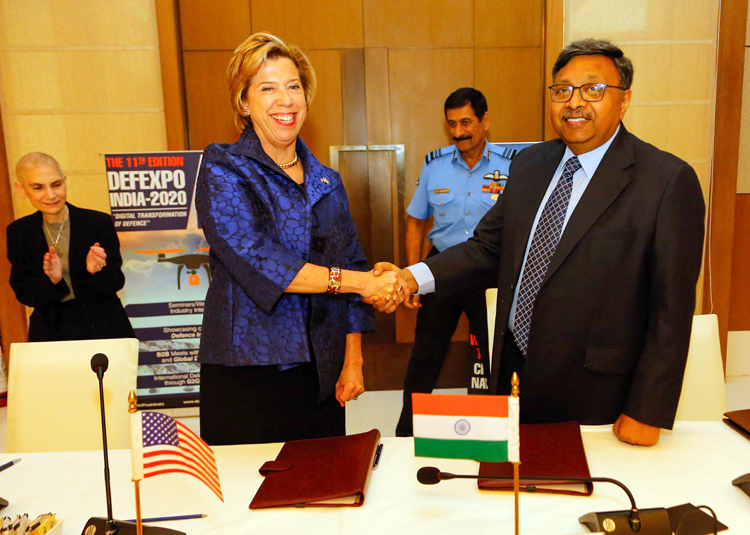INDIAN ARMED FORCES CHIEFS ON OUR RELENTLESS AND FOCUSED PUBLISHING EFFORTS

The insightful articles, inspiring narrations and analytical perspectives presented by the Editorial Team, establish an alluring connect with the reader. My compliments and best wishes to SP Guide Publications.

"Over the past 60 years, the growth of SP Guide Publications has mirrored the rising stature of Indian Navy. Its well-researched and informative magazines on Defence and Aerospace sector have served to shape an educated opinion of our military personnel, policy makers and the public alike. I wish SP's Publication team continued success, fair winds and following seas in all future endeavour!"

Since, its inception in 1964, SP Guide Publications has consistently demonstrated commitment to high-quality journalism in the aerospace and defence sectors, earning a well-deserved reputation as Asia's largest media house in this domain. I wish SP Guide Publications continued success in its pursuit of excellence.
- Prime Minister Modi Visits Punjab’s Adampur Air Base, Interacts with Airmen after Successful ‘Operation Sindoor’; Stern Message to Pakistan
- The layered Air Defence systems that worked superbly, the key element of Operation Sindoor
- Operation Sindoor | Day 2 DGMOs Briefing
- Operation Sindoor: India strikes back with Precision and Purpose
- Operation Sindoor: Resolute yet Restrained
- India’s Operation Sindoor Sends a Clear Message to Terror and the World – ‘ZERO TOLERANCE’
- Japan and India set forth a defence cooperation consultancy framework, talks on tank and jet engines
- Terrorist Attack in Pahalgam in Kashmir: Unfolding a long surgical war against PAK
- Lt General Pratik Sharma takes over Command of Indian Army's Northern Command
India, US agree to work on 7 new Defence co-development projects on specified timelines
Drone Swarms, Counter-Swarm programmes put on DTTI agenda, Joint Working Group on Jet Engine Technology wound up

India and the US on October 24 signed a joint 'Statement of Intent' (SoI) to commit themselves to seven new military co-development projects in order to give energy and momentum to the flagging bilateral Defence Technology and Trade Initiative (DTTI) which has failed to get off the ground since this framework was ambitiously put together in 2012.
The SoI was signed at the 9th DTTI meeting in New Delhi by the visiting US Under Secretary of Defence for Acquisition and Sustainment Ellen Lord and Secretary for Defence Production Subhash Chandra.
The three near-term projects are Air-launched Small Unmanned Systems or Drone Swarming, Light Weight Small Arms Technology and Intelligence-Surveillance-Targetting & Reconnaissance (ISTAR), Under Secretary Lord declared. The near-term projects are intended to gather momentum within six months
"The SOI outlines the need for detailed planning and measurable progress on specific short, middle, and long-term DTTI projects that are identified in the document. This demonstrates how DTTI is making progress and that both sides are fully committed to it," Under Secretary Lord said at a media briefing after the DTTI meeting.
The three near-term projects are Air-launched Small Unmanned Systems or Drone Swarming, Light Weight Small Arms Technology and Intelligence-Surveillance-Targetting & Reconnaissance (ISTAR), Under Secretary Lord declared. The near-term projects are intended to gather momentum within six months.
The two-mid-term projects are Maritime Domain Awareness Solution and Virtual Augmented Mixed Reality for Aircraft Maintenance (VAMRAM).
The two-mid-term projects are Maritime Domain Awareness Solution and Virtual Augmented Mixed Reality for Aircraft Maintenance (VAMRAM)
The two long term projects are Terrain Shaping Obstacle and Counter-UAS, Rocket, Artillery & Mortar (CURAM) system.
Progress on these seven identified projects will be monitored on a monthly basis.
The US co-chair of the DTTI also made a mention of sharing information on best government quality assurance practices for military aviation, besides flight deck design and organisation.
Secretary Defence Production Subhash Chandra concurred on the "key deliverables in the near, medium and long-term".
"While DTTI has been an ongoing process, both sides were now poised to actually achieve tangible outcomes," Chandra conveyed in a statement.
The two long-term projects are Terrain Shaping Obstacle and Counter-UAS, Rocket, Artillery & Mortar (CURAM) system
"Next, we agreed to a near-term timeline to complete a DTTI Standard Operating Procedure (SOP) that will guide us as we try to coordinate projects under two different systems. We identified the upcoming 2+2, potentially this December in Washington D.C., as a near-term opportunity to finalize the SOP," Under Secretary Lord said, referring to the fortcoming joint meeting of the Indian External Affairs and Defence Ministers with their US counterparts later this year.
The Pentagon Acquisitions and Sustainment chief acknowledged that the initiative to develop jet engine technology for India through a joint working group had been aborted. "The original project we had is suspended right now," she declared, admitting that the project ran into US export control laws.
"We could not come to an understanding of what exportable technologies would be useful to the Indians. We did run into a challenge in terms of US export controls. That being said, we think there is an enormous amount of aircreft technology that we could work on together. So, the teams are looking for areas of common interest," she said.
Under Secretary Lord also reported progress on communications interoperability between the Indian and US militaries after the signing of enabling the COMCASA agreement in 2018, disclosing that a secure communication link had been established between the US Navy Pacific Fleet and the Indian Navy Headquarters. "We have installed two Pacific Fleet-provided flyaway Centrix kits in the Indian Navy Headquarters. An agreement (to install these kits) was signed in March 2019. We're also in discussion to install more (Centrix communication kits) in a variety of places," she added.
The two sides have also tried to get Industry more directly involved in the DTTI process. "We're going to formalise this into an Industry to Industry framework. This week, my counterpart and I committed to complete this framework ahead of the 2+2," the US Under Secretary said.





